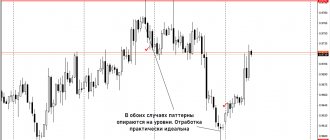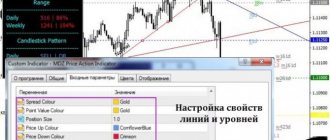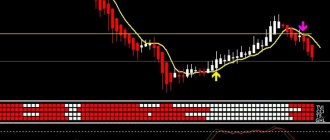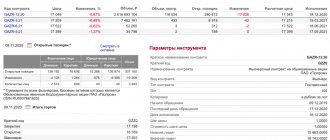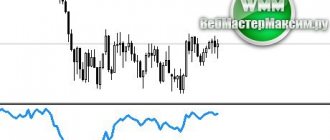This part of the material on option strategies will describe combinations with contracts that use different expiration dates. Moreover, different contract execution dates may be accompanied by identical strikes (horizontal spreads) and unequal execution prices, as in variations of diagonal spreads. By applying these strategies, the trader seeks to make a profit not only by taking into account the price factor, but also time. Such variations of options may seem quite complicated for beginners, so, as a rule, they are used by experienced players. This is about:
Long calendar spread
Let's start with the most famous type of option strategies with different expiration dates - the long calendar spread. It can be executed in two versions: one is a long calendar spread of put options and the second is a long calendar spread of call options.
Long Calendar Put Spread
The Long calendar spread of puts strategy is implemented through the sale of a put option with a near-term expiration date (short-term) and the purchase of a put option with a distant expiration date (long-term), for example, in a month. Both contracts, short-term and long-term (near and far), with the same strikes. The benefit from concluding this type of option is derived from temporary decay. For a short-term option, it is characterized by an accelerated pace, which is why, when its expiration date approaches, redemption is available at low cost. By simultaneously selling a long-term put, which still has time value, positions are closed and income is recorded. Profit is limited to the premium for the long-term put option sold, from which the costs of creating the position, including the funds to purchase the short-term put, must be subtracted. The greatest income will be if, by the date of execution of the nearest option, the market value of the underlying trading instrument will be in the area of the strike with which the positions were created. On the one hand, volatility in this case is not needed, especially when the quotes are close to the execution price of a short-term put, but they affect the increase in the time value of a long-term put without affecting the short-term put, since its time value has already exhausted itself due to imminent expiration . Losses under the strategy are tied to the trends of the long-term put option, but no more than the costs that go into concluding transactions.
Long Calendar Call Spread
Long calendar spread of calls is a strategy when a short-term call option is sold and a long-term call is purchased at the same strike price. The principle of making a profit is the same as in the previous combination of options, only here the redemption is made as the first date of execution of the cheaper call approaches and a contract with a long expiration date that still has a time value is sold.
Choosing a broker
Here you can work with any company, but it must have the following characteristics:
- minimum transaction price;
- a sufficient number of trading assets;
- a diverse set of options;
- suitable expiration date.
Don’t forget that in any case, the broker must be reliable, offering its clients transparent terms of cooperation and methods for withdrawing funds. Then, for maximum convenience, we place the metatrader 4 window next to the window of your broker’s platform:
Short calendar spread
The opposite of the Long calendar spread, accordingly, is the Short calendar spread and it is executed by selling a put or call option with the nearest expiration date (short-term) and purchasing an option with a distant expiration date (long-term). Since an option to buy, due to a larger time range and the presence of time value, will cost more than the one being sold, such strategies are also classified as debit - an investment of capital is necessary. A short calendar spread implies making a profit when volatility decreases. Limited loss will occur when price movements increase. It is understood that the exchange of volatility to end the strategy occurs when the short-term option expires, and then the second, long-term (long-term) contract is closed.
Diagonal call spread
Diagonal call spread or, as it is also called, diagonal bear spread (Diagonal bear spread) is a strategy used by traders who have already gained experience in options trading. Its complexity lies in the formation of a combination, the contracts of which will not only differ in expiration dates, but also in strikes. A diagonal call spread is implemented when there is an initial period of market inactivity and then a decline in the value of the underlying asset.
Initially, an out-of-the-money call option is sold for a short-term period (for example, 30 days) with the strike price at point 1 (as shown in the figure). At the same time, a long-term call contract (for example, for 2 months) with a strike price of 2 is sold. When the expiration time of the near-term option approaches, along with its execution, another call option with strike 1 is sold. It is worth noting that at the first stage of the strategy, time decay plays into the hands, allowing the short-term option to become cheaper faster than the long-term option. After the short-term contract is executed and another one is purchased, the effect of temporary decay ceases to play a significant role, because both the sold and purchased calls will lose value approximately simultaneously. Getting some profit is already possible when creating a position; in any case, the costs should be quite small, but selling the second call option should already provide income. The strategy is executed according to forecasts that the price will be around strike 1 or below it. Since this will allow the sold options to become cheaper and the most favorable option is likely that they will end without execution. Therefore, when quotes are at strike price 1, a decrease in volatility is preferable. If the forecasts did not come true and the trend of the underlying asset went up, reaching strike price 2, and quite possibly exceeding it, then increased volatility is necessary. Because this will not only increase the value of a long call option with a strike price of 2 rather than a short call option with a strike price of 1, lowering the total cost of transactions, but also gives an additional chance that the price will fall to the most reasonable level. Market participants who plan to implement the Diagonal Call Spread strategy, operating with long terms, also need to understand the intricacies of rolling, since the transfer of positions is quite relevant when there are long time ranges between the near and long terms of the contract. This strategy also requires mandatory knowledge about the intricacies of early exercise of options.
We calculate risks
For example, let's take 10 transactions. According to the effectiveness of the Butterfly Gartley strategy, we will be able to close up to 90% of profitable transactions. Therefore, we evaluate our trading deposit and the adequate size of one transaction. According to the rules, this number should not exceed 5-10% of our balance. Otherwise, there simply won’t be enough money for the planned number of operations.
You can always use additional tools to check the signal. An important rule concerns the right time to trade. You should not enter into transactions before the release of important political and economic news, because the schedule at such times is extremely unpredictable, and the strategy may not work. Therefore, in addition to technical analysis, do not forget to take into account the principles of fundamental assessment of the market situation.
Diagonal put spread
In the Diagonal put spread or Diagonal bull spread strategy, like the previous one, there is limited risk, but at the same time there is a limit in the potential for possible profit. Its implementation is recommended for experienced investors who know a lot about analytics, preliminary closing of option positions and rolling. The formation of a Diagonal put spread begins when forecasts tell the trader that the price of the underlying asset will increase in the long term, but before that the activity of price fluctuations will be reduced and neutral for a certain period. The description shows monthly and 2-month contracts, but these terms may vary. The following drawing will also be of great help:
The strategy is implemented in the following stages: an out-of-the-money put option with a strike price of 1 (in the figure, strike price 1) and expiration in 30 days is sold; At the same time, an out-of-the-money put contract with a strike price of 2 is purchased with expiration in a slightly longer period of 60 days. A long-term option plays a hedging role. Thus, transactions for the first stage are considered created and the expiration of the period begins (in our case, 30 days), where the result is significantly influenced by time decay - a contract with a shorter period (1 month) loses value somewhat faster than with a longer execution period. Therefore, if a profit has not yet been made when creating a position, then if the forecasts have taken place, it will be obtained at the next stage: execution of a short-term contract and the sale of a second put with an execution date and strike, like a long-term contract. It is assumed that the price before the first expiration will be below or at the level of strike price 1. For the second stage, after the near execution date, it is necessary to raise quotes above the strike price 1. The fall of the market is insured by the purchased put with a long term. It will reduce losses due to incorrect forecasts. Also, if the price went down at the second stage of the strategy, then increasing volatility can help. Increasing intensity of price fluctuations will cause the value of a long long put option with a strike price of 2 to rise faster than a short in-the-money put option with a strike price of 1. In addition, with volatility, the chances of the underlying asset price returning to the most profitable upper level increase. In the worst case scenario, the total loss will be the total cost of the investment made.
Benefits of the Butterfly contract
The trading systems described earlier do not force the investor to consistently monitor the movements of quotes on the chart. The trader only needs to calculate the price contours of the range, and the value of the asset must remain within the drawn channel.
The strategy allows you to work at low market volatility, when there is no clear demonstration of the direction of trend movement. This is also a normal result if there is excessive activity, due to which it is difficult to foresee a reversal in quotes in advance.
The technique is suitable for novice traders, since it only requires the ability to calculate the boundaries of price movements. But, if a more experienced speculator works according to the method, then the efficiency of the system will increase significantly.
Diagonal spread LEAPS
A strategy that is also found on thematic portals under the names “Covered Stake with Shoulder” and “Fig Leaf”. The last mentioned name more subtly hints at the applied element of coverage of transactions opened when forming a strategy. The Fig Leaf can be executed by traders who have already gained experience with simple tactics and want to try their hand at more complex combinations. This strategy is a little more sophisticated than the Covered Stake. Before you begin, you need to gain knowledge about early exercise of options and rolling. If these are already available along with confidence in the strengths, then at the initial stage of the combination the following two transactions with options are carried out: - purchase of a long-term call option in the money for a period of 1-2 years (such derivatives are also called LEAPS) with an exercise price at level A; - sale of an out-of-the-money call option with an expiration date much closer - in a month and a half and a strike B. LEAPS must be selected so that its price movement is close to the fluctuations in quotes of the underlying asset, that is, with a delta of 0.8 or higher and located at least 20% in money, or even more. A trader decides to execute a Fig Leaf when the forecasts he receives indicate a moderate bullish trend movement. Thus, by opening the mentioned positions, he expects that the price of the short call option will not exceed the strike price and he will have a premium left, since it will be inappropriate for the buyer to exercise his right to purchase the asset. After the first short call expires, the trader sells the next one. And this procedure is carried out several times, bringing bonuses as profit if the situation is successful. Moreover, it is worth noting that if in the case of a covered call (the strategy is described in the article Options: Strategies. Part 2) the investor has assets in his hands, then the Fig Leaf only implies the right to purchase them at strike A in the future. Therefore, for some investors this option becomes preferable if they do not want to direct funds to purchase trading instruments and the result of transactions increases due to the leverage generated by the combination of positions. In the event that the holder of a short-term call contract decides to exercise it, experienced stock market players caution newbies against making the mistake of selling to satisfy the obligations of a long LEAPS call. To fulfill your obligations, it is recommended to purchase the required amount of a real trading instrument. In general, it is not possible to calculate in advance the profit or loss for the LEAPS Diagonal Spread strategy, since these values depend on the premiums of short options sold and the behavior of LEAPS.
Binary options on weekends
This format is very popular now.
As a rule, on modern exchanges you can trade virtually at any time, which also applies to options trading.
There is a type of weekend work that has unique nuances.
As a rule, the user can trade from virtually anywhere, regardless of the area of residence. If one of the exchanges is working, this option is available . For example, at night Moscow time the Tokyo stock exchange operates. American and European open at different times. All this makes the possibility of trading available virtually at any time.
But it will be possible to trade on weekends only when the broker provides such an opportunity. Some may go on vacation on a day off, which automatically cuts off the user’s ability to trade.
On the screen of such a broker, on such days you will only notice an inscription indicating that trading is unavailable. Therefore, I RECOMMEND you to approach the choice of a place for trading as responsibly as possible.
See also: How to delete an account in 24option
Double diagonal
The Double diagonal strategy can be considered one of the complex ones, the correct execution of which can be performed by real virtuosos of the options trading space, since in addition to data analytics to obtain the most probable forecast, it requires precise handling of combinations. Double diagonal is formed with the expectation that the market will be subject to minimal changes for at least two periods, taken as expiration dates for the options participating in the strategy. In describing the Double Diagonal one cannot do without the help of a drawing.
This tactic requires the following operations with different execution prices and expiration dates: Strike A – purchase of a put option with a distant expiration date (for example, the contract period is 60 days) out of the money; strike B – sale of a put with a near expiration date (for example, contract life is 30 days) out of the money; strike C – sale of a call option with a near expiration date (30 days), again, out of the money; strike D – buying a call with a distant expiration date (60 days), also out of the money. That is, this strategy can be thought of as executing a diagonal bear spread and a diagonal bull spread at the same time. The calculation is based on time decay, namely, its faster impact on early contracts than on the rate of evaporation of later ones. As a rule, at the time of drawing up the first stage of the strategy, the market value of the underlying trading instrument is between the execution prices B and C. If it is closer to one of these two levels, then the tactic will have either a bearish or bullish direction. Further price movement without significant fluctuations between the same strikes, B and C, will allow the sold options to end out of the money and will retain the premium received from their implementation in the form of profit. The later options, with strikes A and D, are tasked with reducing risk in the event that the market becomes active and moves the trend beyond the early option strikes up or down. But the main calculation is that the market will remain sluggish and nearby options will expire without claims being made. At the moment when their expiration date approaches, the next, SECOND STAGE of execution of the Double Diagonal strategy begins. It consists of the secondary sale of new put options with strike price B and call options with strike price C. Expiration, as with previous short-term contracts, in our case is 30 days, and it turns out that this time it is equal to the terms of hedging long-range options , those that were concluded for 60 days. From this point on, the strategy is identical to the Iron Condor. If the premiums from the first sale of the call and put did not bring a net profit and did not cover all the costs of the positions opened within the strategy, then the second sale should already create a positive result, of course, in the case when the expected behavior of the market turned out to be correct and it did not make sharp fluctuations in any direction. That is, the goals at the second stage of the strategy are the same - so that the price remains within the boundaries of strikes B and C. It turns out that the most ideal situation with maximum profit is the expiration of four sold contracts (in the first and second stages) out of the money. It is worth adding that traders often buy back near-term options slightly earlier than the contract expiration date in order to eliminate additional risks that may arise in the remaining days before expiration. It should also be noted that Double diagonal becomes an alternative option to the Iron Condor with a long-term period, and is more acceptable, since it allows you to receive a premium from the sale of short-term contracts twice.
This part of the material on option strategies will be a good addition for those who have moved from theory to practice, have tried strategies that are simpler to understand and implement, and are now able to take the next step towards gaining experience in the investment business. Such options trading is accompanied by good knowledge of the market and those factors that can increase investment risks. Of course, before forming positions within the framework of not only calendar option strategies, but also other combinations of transactions, a significant part of the time must be spent studying technical and fundamental information. Then even unforeseen factors will not be able to cause serious damage to capital, since a high-quality forecast provides for a certain level of risks, and a well-executed strategy can reduce it to a minimum.
Preferred assets and indicators
The Butterfly option can work with both indices and stocks. In this case, much depends on the preferred trading system. For example, indices, as practice shows, are much less volatile compared to stocks.
With indices, it is more convenient to use the first of the described strategies, because the likelihood that the chart will remain within the limits outlined by the trader is very high. Shares, in turn, are less stable. In their case, the second option is suitable, based on breaking the upper or lower border.
Indicators as such are not needed. It will be enough if the broker is allowed to independently “draw” the upper and lower lines, defining the boundaries. If you wish, you can use all the available tools to determine the boundaries as accurately as possible, but often this only confuses and does not help.


